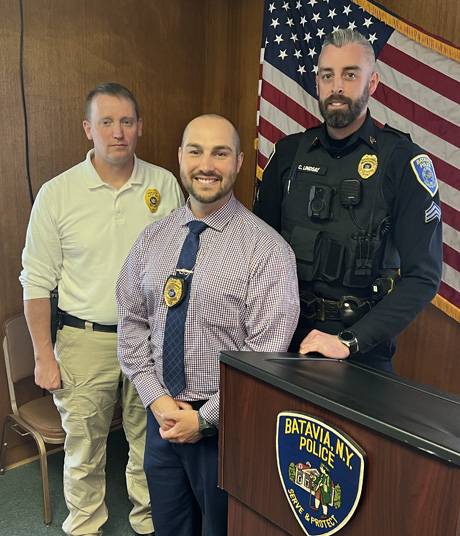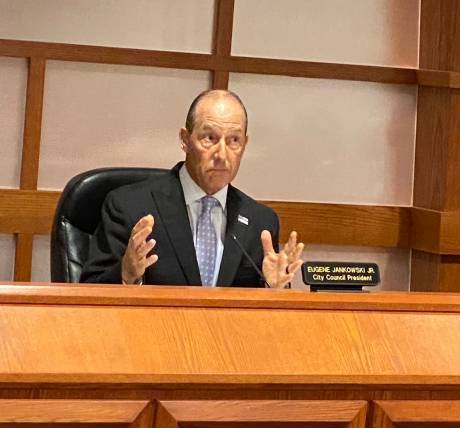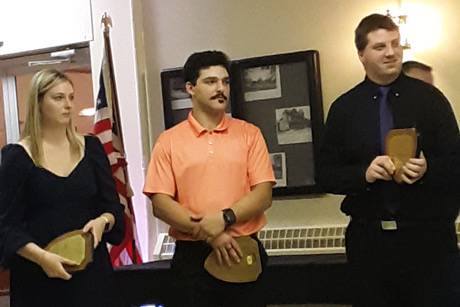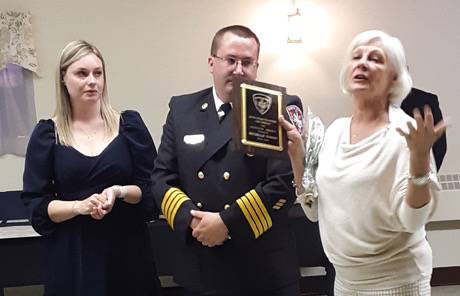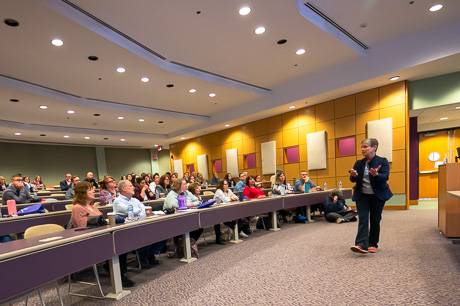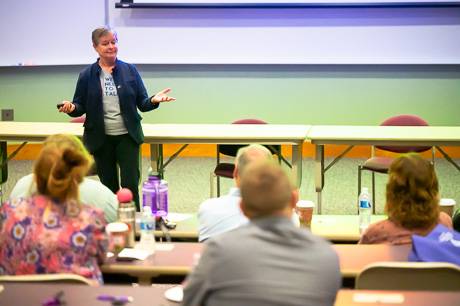Longtime tradition of ag district review continues to ensure 'farm protections'

Only one person spoke during a public hearing about Genesee County’s Agricultural District 1 Wednesday, and it was the organizer of the hearing, Director of the county Planning Department Felipe Oltramari.
He explained the process and importance to conduct reviews and hearings for Ag Districts, which occur every eight years for each of four different districts.
“It’s a very well-known program, it's been around since the 70s. It benefits the farmers and gives them the right to farm protections from the state. So it's a voluntary program that landowners enter into, and we administer. It's an eight-year term that they have to agree to, so this is their one chance to move their property in or out of the district," he said after the hearing and county Legislature meeting. “It’s fairly common for there not to be any speakers because it's not very controversial and protects the farmland, protects the farmers from being able to do the things that farmers need to do without fear of lawsuits and things … it's mostly protection from nuisance lawsuits or from regulations that a town government may place upon them that wouldn't allow them to continue their operations.”
The public hearing was about the review and modifications “for the folks who have asked to be removed and the folks that have asked to be put back in,” he said.
District 1 includes the towns of Alexander, Batavia, Bethany, Darien, Pembroke and Stafford. There are 69,193.97 total acres, and of those, 17,119.86 are owned by farmers, and 7,514.13 are rented by farmers. Since the last review, 1,507.13 acres have been added and 414.82 removed.
Oltramari asked the Legislature to adopt a resolution stating that the public hearing was conducted and the ag district review “has been determined to have no significant effect on the environment after preparing and evaluating a Short Environmental Assessment Form (EAF), and "WHEREAS, the Committee on Public Service does concur with the recommendation of the Agricultural and Farmland Protection Board. Now, therefore, be it RESOLVED, that the Genesee County Legislature does hereby approve of the adoption of the proposal for the continuation and modifications of Agricultural District No. 1 in the Towns of Alexander, Batavia, Bethany, Darien, Pembroke, and Stafford as recommended by the Agricultural and Farmland Protection Board for a period of eight years."
District Review Worksheets were mailed to the 1,200 landowners listed under District 1 on January 22, 2023, allowing them to make modifications to their land’s status and requesting information about their operation, Oltramari said in the county planning report
Owners responded to the mailed worksheets by either returning the included paper form, completing a web-accessible form, or calling the Planning Office. Of the 1,200 worksheets sent, 49.5 percent (596) were returned or had a response recorded.
Returned worksheets account for 64.6 percent of the parcels and 68.3 percent of the acreage. The return rate was higher than the 2015 review, which had a return rate of 40.2 percent, he said.
Altogether, farms account for 39,507 acres (58 percent) of the District. This data analysis is incomplete, however, as the calculations include only a partial estimate of the data attributable to the 50.5 percent of the landowners who did not respond to the mailing.
As a result of the review, 48 properties consisting of 1,440 acres were added to the District, and 220 properties totaling 2,589 acres were removed from the District. These modifications account for a net loss of 1,149 acres or a change of -1.7 percent, the report stated
In accordance with the Department of Planning’s process to revise the Agricultural Districts, properties of less than 2.5 acres without apparent farm-related activities and large-scale non-farm-related commercial properties received a targeted mailing which specified that if they did not respond, the parcel would be removed from the Agricultural District.
As part of this process, 144 targeted mailings were sent out, and 103 parcels totaling 124 acres were removed due to no response being received. These removals account for 4.8 percent of the acreage removed from the District.
Smart Growth, Farmland, Comprehensive Plans
The County has adopted a Smart Growth Plan, an Agricultural and Farmland Protection Plan, and a Comprehensive Plan. The renewal of Agricultural District No. 1 “will be in harmony with the long-term goals of agricultural protection and the economic growth strategies contained within these plans.” The benefits and protections afforded farm operators enrolled in the Agricultural District program help to meet the long-term goals of these plans and are integral to their strategies.
Genesee County’s Agricultural and Farmland Protection Plan (adopted in 2001 and updated in 2017) prescribes a plan of action to boost the economics of local farming. At its core are a series of land use and economic incentives designed to address the bottom line of farm operations. The benefits of the Agricultural District program help to achieve these goals as an incentive to keep lands in agricultural production, the plan states.
The Plan’s second recommendation is to “reaffirm the importance of existing agricultural districts, especially with regard to water and sewer extensions.” The 2017 update found that “Extension of water and sewer infrastructure has been effectively controlled through the County’s Smart Growth Plan, which, as noted above, respects the importance of Agricultural Districts. Recognizing the impacts of extended infrastructure into Agricultural Districts, "the Genesee County Legislature adopted the Smart Growth Plan in May of 2001 to prevent new waterlines from encouraging the development of prime agricultural areas in the County," it states.
What does the renewal of ag districts mean for the county? It gives a boost by "maintaining a financial incentive to keep prime agricultural land in agriculture," the report states.
Local Comprehensive Plans
All of the Towns with lands in Agricultural District No. 1 have adopted Comprehensive Plans. According to the planning report, the adopted plans indicate "a strong desire in these communities to preserve and protect agricultural lands and their rural character." These local plans include:
- The Town of Alexander’s Comprehensive Plan (adopted in 2003) indicates a strong desire to preserve and protect agricultural lands and their rural character.
- The Town of Batavia’s Comprehensive Plan (adopted in 2017) supports agricultural land uses by stating goals to “promote the continued economic viability of agriculture,” “preserve a large, contiguous area of high-quality farmland to ensure a viable land base for continued agricultural production in the Town,” and “reduce the potential for conflict between farmers and non-farming neighbors.”
- The Town of Bethany’s Comprehensive Plan (adopted in 1997 and amended in 2007) indicates that “many residents support the preservation of viable agricultural activity.” The Plan encourages the “development of new agricultural related businesses” and states that “Residential and other developed land uses should be appropriately sited so as to minimize potential conflicts with agricultural activities.”
- The Town of Darien’s Comprehensive Plan (adopted in 2005) states a goal to “Provide for the protection of farmland for agriculture as an important environmental, economic, and aesthetic component of the community, and consider the impacts on agriculture in all actions of the Town.”
- The Town of Pembroke’s Comprehensive Plan (adopted in 2007) provides an objective “to ensure that agricultural land in the Town is protected and remains a viable economic opportunity,” and the Town lists these as action items: “Utilize cluster development and planned unit development practices in rural areas, implement existing land uses ratios to restrict the subdivision of land in viable agricultural areas, and study and inform agricultural Businessmen/ Landowners about the benefits of land trust easements to preserve agricultural land.” The future land use map within the plan identifies the majority of the land in Agricultural District No. 1 as Agricultural and Agricultural/Residential.
- The Town of Stafford’s Comprehensive Plan (adopted in 2007 and revised in 2009) states as a goal to “Support and protect agricultural lands” and “recognize the importance of farming to the character, economy, and spirit of the Town.” The Plan recommends the Town consider “adopting a local ‘right to farm’ law.
The Town of Batavia is the only municipality with lands in Agricultural District No. 1 that has a locally adopted and State certified Agricultural and Farmland Protection Plan. The Plan, adopted in 2010, identifies one of its actions to create an Agriculture Production Zone, stating, “The Town should establish a zoning district that establishes agriculture as a priority use and limits the extent of non-agriculture development.”
Agricultural District No. 1 has met its intended goal, the report summarizes, and in conjunction with the other three Agricultural Districts in Genesee County, it has formed the foundation for the County’s future actions toward agricultural protection and enhancement.
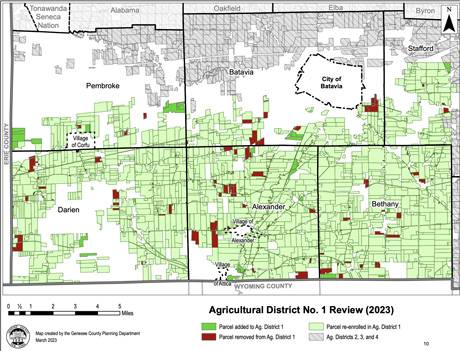
Top file photo of Felipe Oltramari, by Joanne Beck, and image above provided by Felipe Oltramari as part of the Planning Department report.


















